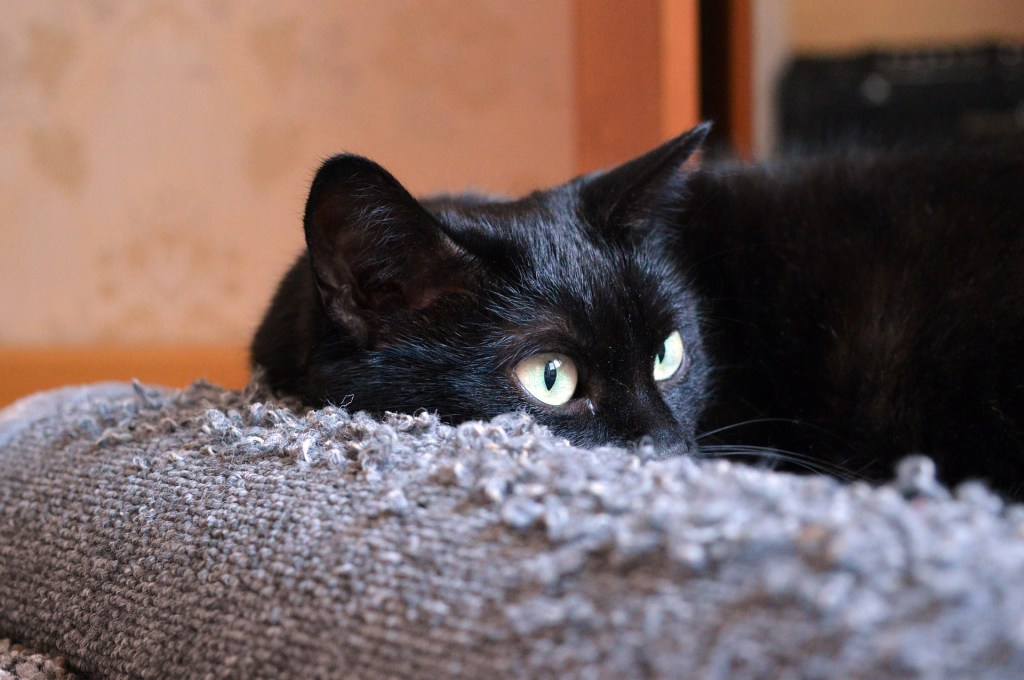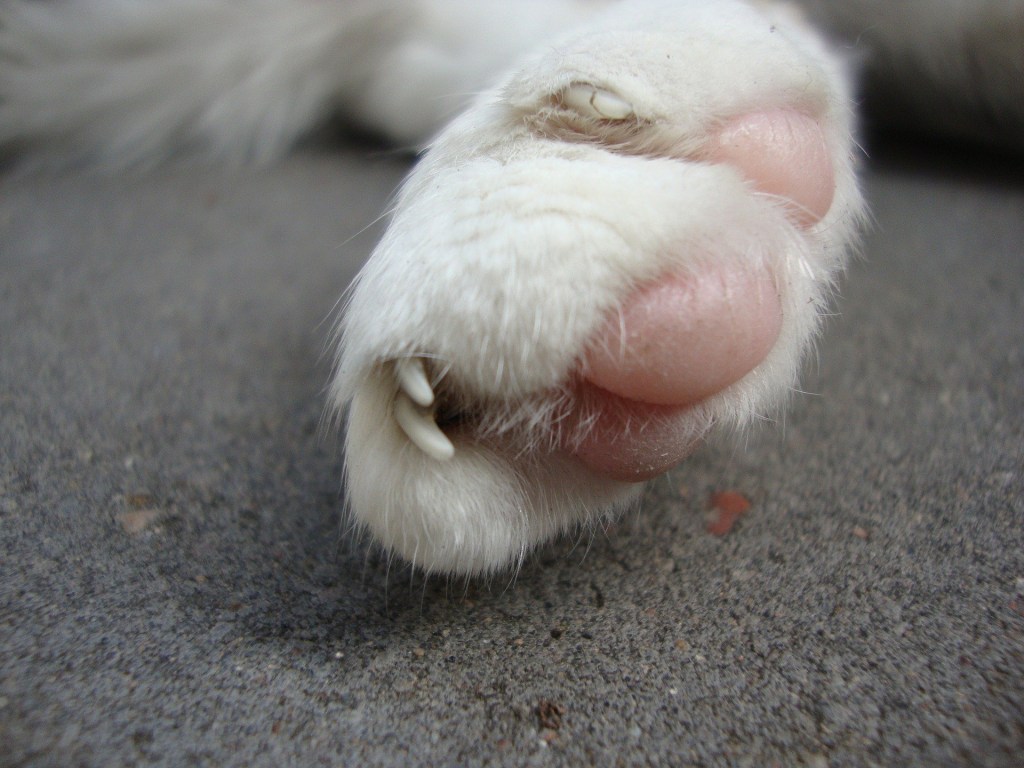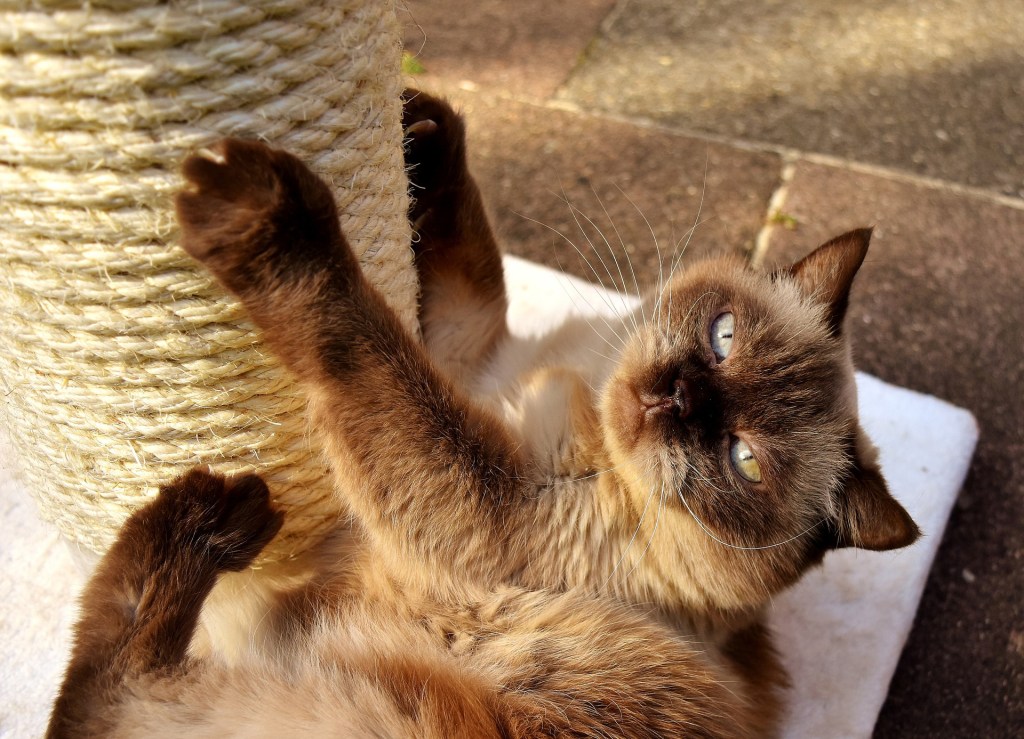Declawing Demythed
Help! My cat is shredding my furniture!
A familiar cry. A dearly-beloved cat can become a menace when it shreds our furniture into ribbons. Perhaps our immediate reaction, particularly when this happens frequently, is to say, “I’m taking that **** cat to be declawed.” It sounds like a simple solution to the problem, doesn’t it? Unfortunately, it isn’t quite as simple as that.

Cat ‘parents’ know that a cat is a wonderful creature: affectionate, loyal, little trouble, independent, beautiful, clean and fastidious. But when expensive furnishings are ruined, it is quite understandable that people will consider ‘solving’ the problem by resorting to, what sounds like, a simple measure. A quick visit to the vet … problem solved, and the cat is actually better off without those nasty, sharp talons. This, however, is not the case.
Let’s imagine that you are considering having your cat declawed. You are at your wits end because yet another chair has been ‘remodelled’ by little Mittens, your delightful little Persian, with a face that is as innocent as the day is long.
Is declawing legal?
Unfortunately, in South Africa, yes, it is. In many countries overseas it has been made illegal though, except for rare cases when it is necessary for medical reasons, such a s tumours or injuries.
So, if it’s legal in S.A., then surely the vets have approved it?
The South African Veterinary Council, the governing body of all vets in South Africa states:
“If the benefit of a procedure outweighs the risk to the animal, then it is in the animal’s best interests to have the procedure done. If the procedure provides no benefit or a very small benefit, compared to the risks, then the procedure should not be performed.”
Why do cats scratch my furniture?
Scratching is a normal instinct for a cat. They have no deliberate intention of destroying your furniture or of being ‘naughty’. They scratch to remove the dead bits and pieces from their claws, called ‘husks’. They also do it to stretch their muscles and to mark their territory. They begin scratching from around 8 weeks old, so this is the ideal time to start to train them to use a scratching post. More about this later.
What happens when a cat is declawed? Surely, it’s like having a manicure?

Cat declawing is a far cry from having a manicure. It is not as simple, or as painless as simply clipping the nails. Declawing is a surgical procedure, done under anaesthetic, which involves amputating the last bone of each toe on the front paws. Imagine having the ends of all your fingers cut off at the last joint. Once the bones are amputated, surgical glue or stitches close the wounds and the paws are bandaged. Laser surgery is another option in which the cutting is done with a laser. A tendonectomy is another option, in which the tendon attached to each toe is cut. The claws are not removed, but the cat cannot control them or extend them. Unfortunately, this procedure can cause the claws to become very thick so that they need to be trimmed often to prevent them from catching on surfaces. Complications from this surgery may result in the cat having to be declawed later. The incidence of bleeding and infection from the tendonectomy has been found to be similar to the declawing procedure.
What happens post-surgery?
Cats declawed with a laser tend to have less bleeding than the ones declawed with a scalpel or guillotine, but it will still take up to two weeks for your cat to recover. He/she basically has to learn to walk and balance all over again, as the declawing permanently changes the cat’s anatomy. Post-surgery complications may include aggression, disfigurement of the feet and nerve damage. Your cat will need to be able to rest and be quiet for at least a few days.
What are the effects of declawing?
Possible side effects are: pain, necrosis (where the tissues die), infection, back pain and lameness. Declawing changes the way the cat’s paw touches the ground – it’s a bit like wearing a very uncomfortable shoe, all the time. If claws were not properly removed, they can regrow and bone spurs may develop.
A study was published in the Journal of Feline Medicine and Surgery in 2017, entitled ‘Pain and adverse behaviour in declawed cats’. Nearly 300 cats, clawed and declawed were studied, and the conclusions were that “Declawing cats increases the risk of unwanted behaviours and may increase risk for developing back pain”. Amongst the declawed cats, some had retained bone fragments in their paws which increased the risk of back pain and adverse behaviours. The problem is that declawed cats often have difficulty walking because they have to walk on cartilage, not bone, once the ends of their toes are removed. Many owners have also reported that their cats have become more aggressive after surgery. The study also reported that declawed cats were:
- seven times more likely to urinate in ‘inappropriate’ places
- four times more likely to bite people
- three times more likely to ‘overgroom’
- three times more likely to be aggressive
- three times more likely to suffer from back pain and chronic pain in their paws.
- more likely to find soft surfaces on which to urinate because its less painful than using the litter in their boxes
Cats’ claws are of course a means to defend themselves, so this becomes a problem when they are declawed, increasing the likelihood of their biting to defend themselves. Some vets believe that if an outdoor cat is declawed, then they should become an indoor cat, as they are unable to defend themselves properly. A cat bite, for a human, is more likely to become infected than a scratch. The lead author of the study stated: ” We now have scientific evidence that declawing is more detrimental to our feline patients than we originally thought and I hope this study becomes one of many that will lead veterinarians to reconsider declawing cats.”
Aren’t there pros and cons though to declawing cats?
There is still a lot of controversy over this surgery. Some people argue that as we have domesticated animals we have adapted certain aspects of some animals to improve their lives and ours. They may say that declawing benefits the cats because the alternative may be an animal shelter or euthanasia. They may also say that if the procedure is done in a sterile operating theatre, with a general anaesthetic and if the cat is given effective painkillers afterwards, with good post operative care, then the procedure is warranted, as the animal will then be assured of a loving home for the rest of its life.
Those who argue against declawing will point out, not only the possible side effects of this surgery but also the fact that there are alternatives to declawing, like training the cat not to claw the furniture, or putting small sleeves on the claws. To take away one of the cat’s primary methods of self-defence, they may say, is inhumane. Cats’ claws are not only a means of defence but they enable the cat to move around its territory, scaling walls and climbing trees.
Are there alternatives to declawing cats?

- Provide little Mittens with plenty of scratch posts. These can be bought or you can improvise your own. You could tie carpet or wrap rope around a wooden post. Try to provide several alternatives to keep Mittens happy. Corrugated cardboard makes very effective scratching posts too. Make sure that all posts are tall enough for Mittens to stretch fully – remember that scratching is also a natural way for her to exercise her muscles. Sprinkle cat nip on and around the posts to encourage her to use them. Of course, it is possible that Mittens will still prefer the corner of your lounge suite to clean her claws, so you may have to train her a wee bit. A spray bottle of water kept near the favourite places to scratch is effective if you can catch her scratching. A loud noise made each time she goes near may also act as a deterrent.
- There are products you can buy to stick on your furniture which are intended to deter scratching. Cats hate to have their paws come in contact with anything sticky, so double-sided tape should also work. Packing tape will also work, attached in horizontal strips to the favourite scratching areas.
- You may be able to get nail caps, or ‘Soft Paws’, from your vet or purchase online. These are glued to the claws and last about four to six weeks. You can do this yourself (Good luck with that!) or your vet will sedate Mittens and glue them on.
- Discuss the situation with your vet, who may be able to suggest a solution for you.
Finally…
As the declawing of cats is legal in South Africa, if you are a cat ‘parent’ with the remnants of an expensive couch in your lounge, you have a decision to make. However, remember that you are not alone when making decisions regarding the welfare of your pets. Your vet is always there to assist and to give you his/her professional advice.
ZA-BRV-211100005

Subscribe to our Newsletter
Get to know your furry friend better! Sign up for all things dog- or cat-related.
The Hairy Facts about the dreaded hairball
12 April 2021
Help! My dog’s barking mad! Volume 2
12 April 2021
Your Itchy, Scratchy Cat – All About Cat Skin Problems
12 April 2021
The Dog’s Diet: A Bone of contention?
01 April 2021
Mango Fly Worms: How to Spot and Eliminate them
Posted on November 28,2019
Managing Mange And Mites In Your Dog
Posted on June 11,2018
Why Do Cats Purr and How? Learn What Your Cat Is Saying
Posted on October 14,2020
How to Get Rid of Ear Mites in Dogs
Posted on November 06,2019









